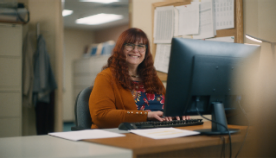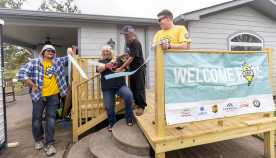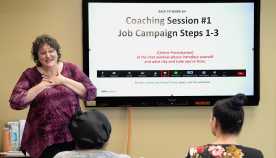About Us
More than 39 million older adults are either living in poverty or are on the brink of falling into poverty, and the cost of basic necessities is fast outpacing the earnings of many seniors who live on low or fixed incomes. Millions of older adults need help now — and the need increases as our nation’s population ages.
- SNAP Enrollment Assistance
- Medicare Savings Programs
- Financial Wellbeing for Family Caregivers
- Earned Income Tax Credit
- Student Loan Support
Older adults face multiple challenges, including food insecurity, caregiving responsibilities, growing debt, health issues and social isolation. Systemic racism and discrimination based on age, gender, ability and other factors can also limit access to social services or to living-wage jobs that come with benefits. Lack of clear, reliable information means many eligible older adults aren’t enrolled in benefits programs that can help.
AARP Foundation provides services and supports programs that help older adults living with low income gain access to benefits for which they’re eligible. In 2022, our Benefits Access efforts helped 212,219 people over 50 with low income secure almost $225 million in benefits.
SNAP Enrollment Assistance
Through grantmaking, AARP Foundation supports nonprofit community organizations that help older adults enroll in the Supplemental Nutrition Assistance Program (SNAP, formerly known as food stamps) so they can afford healthy food.
These efforts helped more than 52,000 eligible older adults receive over $105 million in SNAP benefits in 2023. On average, older adults in the communities we serve receive about $153 a month. On average, older adults in the communities we serve receive about $153 a month, helping them afford nutritious groceries, including fresh fruits and vegetables. Learn more about SNAP.
Medicare Savings Programs


Costs related to Medicare can be a significant portion of the budget for an older adult with low income. Medicare Savings Programs (MSP) make Medicare more affordable by helping to pay premiums, deductibles, coinsurance, copayments and prescription drug coverage costs.
In 2023, we helped 10,704 older adults with low income access $73,042,998 in health care benefits, assisting with enrollment in Medicaid, Medicare Savings Programs, and the Part D Low-Income Subsidy program. On average, older adults were connected with health care benefits that saved them $6,823/year, making it easier to afford medical coverage and prescriptions. Learn more about Medicare Savings Programs.
Financial Wellbeing for Family Caregivers
“Can I get paid to take care of my loved one?”
About 48 million people in the United States care for an adult loved one without pay, and for an average of nearly 24 hours a week. Roughly 54% of family caregivers are over 50, and nearly 10% are over 65.
Caregiving for a family member can be draining, both emotionally and financially. Considering that 36% of all family caregivers have a net income that’s less than $50,000, the costs of caregiving can be overwhelming.
Yet finding reliable information about whether and how to get paid as a family caregiver takes time — something caregivers already have too little of. AARP Foundation Paid4Care™ hub, developed with the support of UnitedHealthcare, tackles the question family caregivers ask most often: “Can I get paid to take care of my loved one?”

















